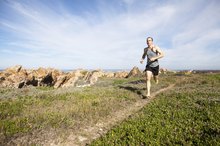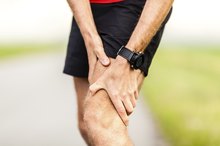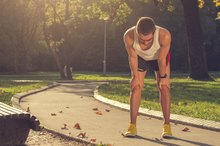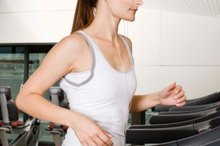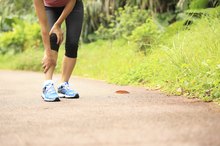What does fact checked mean?
At Healthfully, we strive to deliver objective content that is accurate and up-to-date. Our team periodically reviews articles in order to ensure content quality. The sources cited below consist of evidence from peer-reviewed journals, prominent medical organizations, academic associations, and government data.
- British Journal of Sports Medicine: Exercise Related Transient Abdominal Pain
- British Journal of Sports Medicine: Exercise Related Transient Abdominal Pain
The information contained on this site is for informational purposes only, and should not be used as a substitute for the advice of a professional health care provider. Please check with the appropriate physician regarding health questions and concerns. Although we strive to deliver accurate and up-to-date information, no guarantee to that effect is made.
Cramping During Crunches
Muscle cramps that result from exercise -- and muscle cramps in general -- are not a clearly understood phenomenon. Dehydration, eating habits and fatigue have been found to be contributing factors to cramping. Holding muscles in one place for too long can also contribute to cramping, and the abdominal muscles are particularly prone to this because they are short and tend to stay contracted longer than other muscles. Following some simple preventative steps can help avoid cramping when doing crunches.
If you are experiencing serious medical symptoms, seek emergency treatment immediately.
Features
Cramps are painful, involuntary contractions muscle groups. More severe cramps are felt as a sharp, stabbing pain and milder versions feel like a pulling sensation or mild ache. Cramps can happen at any time but you could be more predisposed to getting cramps, according to the American Academy of Orthopaedic Surgeons -- particularly when you exercise 2.
Causes
How to Recover From Bad Running Leg Cramps
Learn More
The exact mechanism that causes muscle cramps isn't clear, but fatigue, heat, dehydration, and lack of conditioning play a role.cause:
- The exact mechanism that causes muscle cramps isn't clear
- but fatigue
- heat
- dehydration,
- lack of conditioning play a role
If you are overexerting yourself or your muscles are tired, cramps are more likely to occur because the muscles are fatigued and can't function properly. Eating too much or gassy foods before doing crunches can affect the digestive process, which can lead to cramps as well. Another common cause of stomach cramps, which can be related to dehydration, is lack of electrolytes. Too little of any of these in your body can cause cramping. In less-common instances an underlying medical disorder, such as thyroid disease, can cause abdominal muscle cramps.
- The exact mechanism that causes muscle cramps isn't clear, but fatigue, heat, dehydration, and lack of conditioning play a role.cause: * The exact mechanism that causes muscle cramps isn't clear
* but fatigue
* heat
* dehydration,
* lack of conditioning play a role If you are overexerting yourself or your muscles are tired, cramps are more likely to occur because the muscles are fatigued and can't function properly. - Eating too much or gassy foods before doing crunches can affect the digestive process, which can lead to cramps as well.
Prevention
Taking some simple preventative steps may help avoid cramping. To avoid dehydration, start drinking water the day before you do your crunches. Drink 1 to 3 cups of water before you start your routine, and sip water liberally during your workout. Drinking a sports drink or water enhanced with electrolytes can help if you have been sweating a lot. Avoid drinking too much water, which can lead to over-hydration and possibly cramps. To fuel your body properly, eat a smaller meal no less than two to four hours before you work out or a small snack no fewer than 30 minutes beforehand. Perform a warm-up before you do your crunches, and gently stretch the muscles of the abdomen by slowly twisting from side to side or bending backward at the waist. Mix up your routine by adding other abdominal exercises or doing exercises for other parts of the body between sets of crunches.
- Taking some simple preventative steps may help avoid cramping.
- To avoid dehydration, start drinking water the day before you do your crunches.
Treatment
What Are the Causes of Cramps in Feet?
Learn More
As soon as you start to feel your muscles cramp, stop doing your crunches and gently stretch the abdominal muscles. Grab the muscles the are cramped and either massage them or put pressure on them until the cramp goes away. If you are dehydrated, drink some water, preferably with added electrolytes. Focus on your breathing and push your abdomen out when you inhale and relax it when you exhale. If the muscles are tense or tight, apply heat -- and if they are sore or tender apply ice for 20 minutes at a time. If they continue to cramp or feel sore, seek medical attention as you may have strained a muscle. Consult a doctor if you continually cramp up doing crunches despite taking preventative measures.
- As soon as you start to feel your muscles cramp, stop doing your crunches and gently stretch the abdominal muscles.
Related Articles
References
- Military.com: How to Avoid Stomach Cramps When Running
- American Academy of Orthopaedic Surgeons: Muscle Cramps
- British Journal of Sports Medicine: Exercise Related Transient Abdominal Pain
- FitClick: Why Do I Cramp Up When I Do Crunches?
- University of Maryland Medical Center: Dehydration
- Young G. Leg cramps. BMJ Clin Evid. 2015;2015
- Jahic D, Begic E. Exercise-associated muscle cramp-doubts about the cause. Mater Sociomed. 2018;30(1):67-69. doi:10.5455/msm.2018.30.67-69
- Waters TR, Dick RB. Evidence of health risks associated with prolonged standing at work and intervention effectiveness. Rehabil Nurs. 2015;40(3):148-65. doi:10.1002/rnj.166
- Skogar O, Lokk J. Pain management in patients with Parkinson's disease: challenges and solutions. J Multidiscip Healthc. 2016;9:469-479. doi:10.2147/JMDH.S105857
- Hallegraeff J, De greef M, Krijnen W, Van der schans C. Criteria in diagnosing nocturnal leg cramps: a systematic review. BMC Fam Pract. 2017;18(1):29. doi: 10.1186/s12875-017-0600-x
- Mcdermott MM. Lower extremity manifestations of peripheral artery disease: the pathophysiologic and functional implications of leg ischemia. Circ Res. 2015;116(9):1540-50. doi:10.1161/CIRCRESAHA.114.303517
- Blyton F, Chuter V, Walter KE, Burns J. Non-drug Therapies For Lower Limb Muscle Cramps. Cochrane Database Syst Rev 2012; 1:CD008496.
- Grandner MA, Winkelman JW. Nocturnal leg cramps: Prevalence And Associations With Demographics, Sleep Disturbance Symptoms, Medical Conditions, And Cardiometabolic Risk Factors. PLoS One 2017; 12:e0178465.
- Allen RE, Kirby KA. Nocturnal Leg Cramps. Am Fam Physician 2012; 86:350
- American Academy of Sleep Medicine. Sleep Related Leg Cramps. In: International Classification of Sleep Disorders, 3rd ed., American Academy of Sleep Medicine, Darien, IL 2014. p.299-303.
- Maquirriain J, Merello M. The Athlete with Muscular Cramps: Clinical Approach. J Am Acad Orthop Surg 2007; 15:425.
Writer Bio
Solomon Branch specializes in nutrition, health, acupuncture, herbal medicine and integrative medicine. He has a B.A. in English from George Mason University, as well as a master's degree in traditional Chinese medicine.



